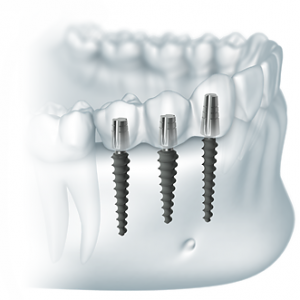Dental implant without incision

Since the advent of implantation in the market of dental services, during the traditional implantation of teeth, the gum was cut without fail.
Dental implantation without an incision is becoming increasingly popular.
This is one of the most modern and optimal methods for restoring lost teeth.
With the classical method of implantation, the gum is cut and the flap is turned away, which is necessary for the convenience and control of the accuracy of implantation.
Such an installation guarantees the engraftment of the titanium root in the jawbone, the absence of complications during and after the operation, thus prolonging the life of the implant.
Thanks to modern technology, it became possible to simplify the process of implanting titanium structures.
Computed tomography makes it possible to give a complete assessment of the structural features of the jaw, and the use of a surgical template allows you to most accurately and at the required angle to install the implant in the jaw bone.
Due to the small size implants and a special technique of implantation, it is possible to implant them in one medical appointment, without significant damage to the gums and trauma to the oral cavity.
If you do not take advertising tricks into account, then there are only two methods of implantation without incisions:
- Implantation of an implant immediately after tooth extraction. Since there is a hole in the gum, it is possible to install the structure into the hole formed without making an incision, followed by installing a crown on it.
- Installing a titanium root through a puncture in the gum. In some clinics, the puncture is performed using a laser, after which the implant is implanted.
Features
- High-quality implants of the latest generation are required.
- Laser implantation of the teeth without an incision requires a laser installation in the clinic.
- An implantologist surgeon must have a high level of qualification and sufficient experience in conducting such operations.
- For the implant implantation operation, it is necessary to have special equipment of European quality: an orthopantomograph, digital visiograph, dispenser.
Benefits

- During dental implantation without incisions, depulpation and turning of adjacent teeth are not performed.
- Minimum invasiveness of the procedure.
- The operation is carried out in a short period of time and is not accompanied by unpleasant sensations.
- Safety of the procedure, since the possibility of damage to the jaw nerve and other anatomical formations is excluded.
- The postoperative period is much easier than after implantation in the classical way. There is no soreness, swelling and bruising.
- High percentage of implant survival.
- When using laser implantation technology, one hundred percent survival of titanium roots is ensured.
- Implant healing takes place much faster due to less tissue damage.
- Tissue healing is faster, because bone circulation is not disturbed.
- The ability to install the prosthesis immediately after implantation of the titanium rod, which provides good aesthetics.
- Implant implanted through the gingival puncture, provides an even distribution of the masticatory load.
- The chewing function is fully restored.
- The service life of such implants is at least ten years.
- The number of visits to the doctor is reduced.
- The cost of the operation is lower than with the classical method of installation of structures.
- Relieves the patient from the need to use removable dentures.
- It is possible to restore any number of teeth of various lengths.
disadvantages
- The lack of visual control over the implantation of the structure and the condition of the bone tissue. The presence of the risk of improper selection of implants.
- The presence of a large number of contraindications.
- With a lack of bone tissue, its building is required.
Video: “Dental implant without incision”
Indications
To restore teeth using a gum puncture is possible in the following cases:
- In the absence of one or more teeth.
- If there are no extreme teeth.
- With full adentia.
- If fast tooth restoration is required.
- If the patient wants to carry out tooth restoration with a minimum visit to the dentist.
Contraindications
- The presence of diseases in the oral cavity.
- In the presence of severe diseases of the internal organs.
- Diseases of the blood: a violation of its coagulability.
- Malignant neoplasms.
- Acute infectious diseases.
- The presence of pregnancy and lactation.
- Patient engaging in sports associated with the risk of increased trauma.
Stages
The procedure of implanting teeth without an incision involves only two visits to the doctor. Unlike classical implantation, the installation steps are not so extended in time.
- Preoperative period. During this stage, a complete examination of the patient is carried out, indications and contraindications for the procedure of implantation of titanium roots are revealed. The selection of implants. If necessary, treatment is carried out for gums and teeth, bone building or sinus lifting. The duration of this period depends on the complexity of preparation for implantation and can take from several weeks to six months.
- The operation. It is carried out using local anesthesia. The procedure does not require incisions and suturing. After installing the implant on the abutment, a temporary crown made of metal-plastic is fixed.
After one and a half to two months, after the engraftment of the titanium root, permanent dental crowns are established.
Implant placement can be done with or without a surgical template.
Surgical Template Implantation

For implantation without incisions, one of the types of patterns is used:
- Based on the oral mucosa and teeth.
- Based on the oral mucosa.
- Only with teeth.
For the manufacture of a surgical template, 3D modeling is used.
A surgical template made in a special laboratory is fixed on the jaw and implants are implanted through specially prepared holes without cutting the gum.
Immediately after installing the structures, the crowns are fixed.
Implantation without the use of a surgical template
After studying the results of computed tomography, the doctor plans a place for implantation of the implant “by eye”, and then proceeds with surgery.